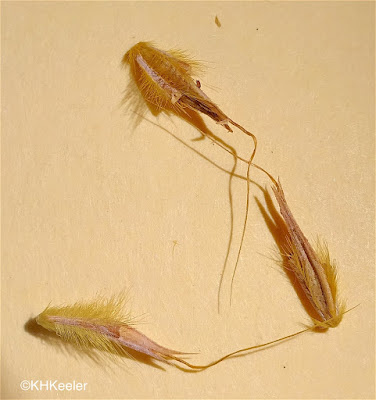 |
| Big bluestem in a Kansas tallgrass prairie |
It remains an important forage grass. The new shoots are very nutritious and very attractive to cattle. Where cattle have enough space, big bluestem does well. If the pasture is small, they preferentially graze it until none is left. Range mangers try to maintain big bluestem or reseed with it.
Big bluestem can be 6' tall on a wet year, so roads departments are not excited to have it along roadsides, the refuge of many tallgrass prairie plants. Often big bluestem is more like 3-4' tall, however. You see it planted sometimes as an ornamental grass, but it tends to get tall and then flop over, not what gardeners usually want.
 |
| Big bluestem as an ornamental at the University of Michigan, Ann Arbor |
 |
| Leaves and flowering stalks of big bluestem |
Andropogon means "man-beard" referring to the fine hairs--beard--on the single-seeded fruits (called achenes). The species epithet, gerardii, honors Louis Gerárd (1733-1819) the French botanist who first described the grass, from plants cultivated in Provence, France. (To make a noun ending in a consonant into the possessive (genitive) in Latin, requires two i's. gerardii means "Gerard's." I pronounce both i's: ger ard ee ay. )
 |
| Big bluestem achenes (fruits). The seed is inside. Note the hairs. (Photographed on a manilla folder, achenes are 3/8" long, the awn (thread-like projection) almost 1/2" more) |
Big bluestem dominated the tallgrass prairie, forming up to 80% of the grassland; imagine a bale of prairie hay: 80% was big bluestem. Part of its success was due to deep roots; the plant went 6' up into the air and 6' down into the ground. In the 25 or more inches of rainfall of the Corn Belt, it got plenty of water and could hang on through moderate droughts. Its deep roots took water from other plants and its 2-3' long leaves blocked them from the sun.
It was a major contributor to the excellence of the soils in the U.S. Midwest; its fine roots left rich organic matter in prairie soils.
Another part of big bluestem's success was its reaction to fire: it was stimulated. Truly, big bluestem grew bigger and flowered more the season after a prairie fire. Like almost all grasses, its apical meristem (growing point) is below ground, so a fire cleared off dead leaves but did not kill the meristem. Most grassland fires move fast, heating the top of the soil--a great insulator--only very briefly. With their meristems intact, the grass leaves, like human hair, grew back quickly from the base. Assuming ample water, big bluestem created a green lawn within about three days after a prairie fire.
 |
| A couple days after a prairie fire: see all the new green grass blades? (And some beige unburned grass--fires are often patchy). |
Most other plants do not respond as quickly or as strongly to fire, so big bluestem was able to shade and crowd them, leading to its dominance. Where fires are suppressed in tallgrass prairie, big bluestem is much shorter and other species expand.
 |
| This apparent monoculture is a native prairie, big bluestem (looking beige, redbrown and green in the photo) dominating and flowering the summer after a spring fire |
Like many plants with large ranges, big bluestem shows lots of variation. The grasses in the photo below, short and tall, red, brown and yellowish, are all big bluestem, growing together in a research garden, soybeans in the background.
Big bluestem is an important, well-adapted native grass that settling the Midwest largely eliminated. It persists on grazing land and in prairie remnants. It would be great to find places to plant back more of it across its native range.
 |
| A stand of big bluestem in September at the Chipman Preserve near Kalamazoo, Michigan |
Comments and corrections welcome.
More on the tallgrass prairie: link
More on little bluestem link
I can give you references if you ask but I did ecology research on big bluestem for 20 years, have seen most of what I wrote for myself, and don't remember where I learned each fact any more.
Kathy Keeler, A Wandering Botanist
More at awanderingbotanist.com



Love it! I just had my first large scale encounter with big bluestem's co-inhabitant of the Tallgrass prairies, Schizachyrium scoparium, and thought it was a seriously handsome species.
ReplyDeletehttps://poasession.blogspot.com/2019/09/little-bluestem-schizachyrium-scoparium.html